|
Revell's 1/32 scale
Heinkel He 162A
|
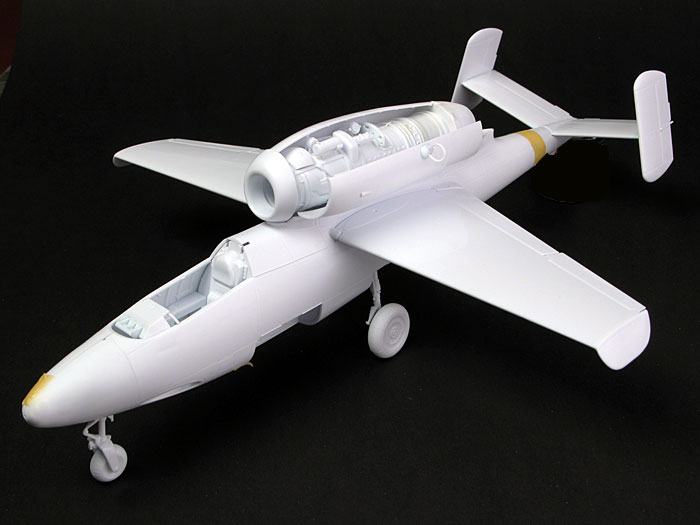 |
|
Test shot of Revell's forthcoming 1/32 scale He 162A partially
assembled.
Major components (eg wings, fuselage halves, tailplanes) have not
been glued at this stage. |
Preview
S u m m a r y
|
| Catalogue
Number: |
04723 - Heinkel He 162 |
| Scale: |
1/32 |
| Contents and Media: |
87 parts in coloured styrene;
4 parts in
clear styrene. (please note - these are pre-production test shots) |
| Price: |
Available for pre-order:
from Squadron for USD$27.46
from
Hannants for GBP£19.99 (to European Customers)
or £17.02 to other export destinations. |
| Review Type: |
FirstLook |
| Advantages: |
Excellent (and appropriate) surface
texture; good level of detail; includes full engine and positionable
cowl doors; exceptional fit; fast construction possible; thin and
clear transparencies; two-part canopy; engineered to minimise
ejector pin marks; open cannon ports; brake lines moulded onto gear
legs; harness moulded on seat. |
| Disadvantages: |
Some sink marks on fuselage
side |
| Recommendation: |
Highly Recommended |
Previewed by Brett Green
Test-assembled by Steve Palffy

Revell's
forthcoming 1/32 scale Heinkel He 162A may be pre-ordered online from Squadron.com
Yesterday on my doorstep, unheralded, sat a slightly crushed box
simply labelled "Revell". Inside were test shots from two exciting
forthcoming releases. Today I will tell you about the sprues for the
Revell 1/32 scale Heinkel He 162 "Salamander". You'll have to wait until
tomorrow to hear about the second kit!
I should point out that these are pre-production test shots, and
there may be further revisions before the kit is released later this
year. I also believe that the white plastic will not be the final colour,
and has most likely been chosen as an easy way to distinguish this
latest revision from earlier test shots. Having said that, the contents
of these sprues will probably be very similar to the production version.
Revell's 1/32 scale Heinkel He 162 comprises 87 parts in coloured
injection moulded plastic on four sprues, and 4 clear parts. Comparison
with photos that I took of test shots on display last month at the IPMS
Nationals in Phoenix shows that the moulds have been modified. The nose
cone has a more rounded profile compared to the slightly pointy shape on
the earlier sprues. This is a noticeable improvement. The fuselage,
wings and tailplanes certainly capture the distinctive lines of the
Volksjager.
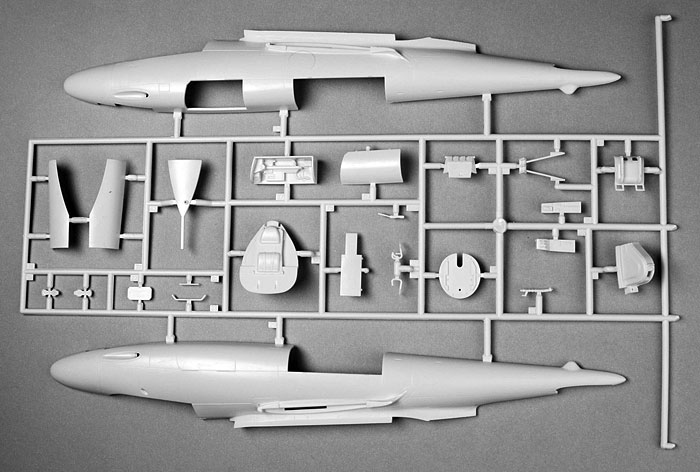
Click the thumbnails below
to view larger images:
The Heinkel He 162 was a simple aircraft, and the relatively small
number of kit parts reflects that simplicity. However, this does not
imply any compromise in detail. The kit includes a full BMW 003E engine,
positionable clamshell engine cowling doors, a nicely detailed cockpit,
a gun bay with poseable access panel, and wheel wells packed with
structural features. The gear legs are nicely rendered with brake lines
moulded in place. The wheels are outstanding too.

Click the thumbnails below
to view larger images:
The quality of the exterior surfaces is also very good. Many of the
major parts on the He 162 were wooden. These areas, including the nose
cone, the main section of the wings and the tailplanes, are accurately
depicted smooth and featureless. Metal sections have fine panel lines
and some rivet detail. I particularly like Revell's reproduction of the
simple hinges on the He 162. The deep cannon troughs, continuing through
to separate parts for the cannon barrels inside the fuselage, are also
noteworthy.
Ejector pin marks - those raised or recessed circles usually seen in
various locations on kits - are a perennial challenge for kit
manufacturers. They are an unavoidable by-product of the injection
moulding process, but Revell has cleverly designed the kit so that the
marks will not be visible once the kit is assembled. The usual areas
that you would expect to see ejector pin marks, including the inside of
the big engine cowlings and the gear doors, are completely unblemished.
There are a few ejector circles on the inside of the forward fuselage,
but even these have been located away from the moulded-on sidewall
detail.
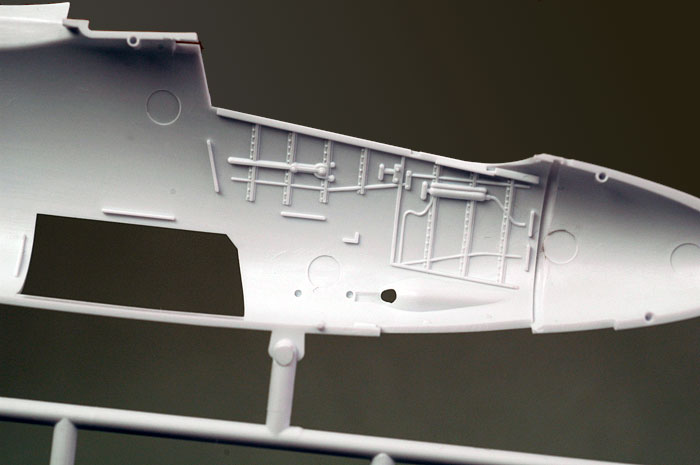
The only (minor) problem that I can see is some sink marks on the
outside of the forward fuselage, corresponding to the position of the
interior structural detail. Although they are theoretically
imperfections, to my eye they give this area the illusion of stressed
metal! If you don't like it, a few minutes with putty and a sanding
stick will eliminate these sink marks.
The transparencies are very thin, beautifully clear and free of
distortion. There is a two-part canopy, a gunsight and the small window
in the forward wheel well.
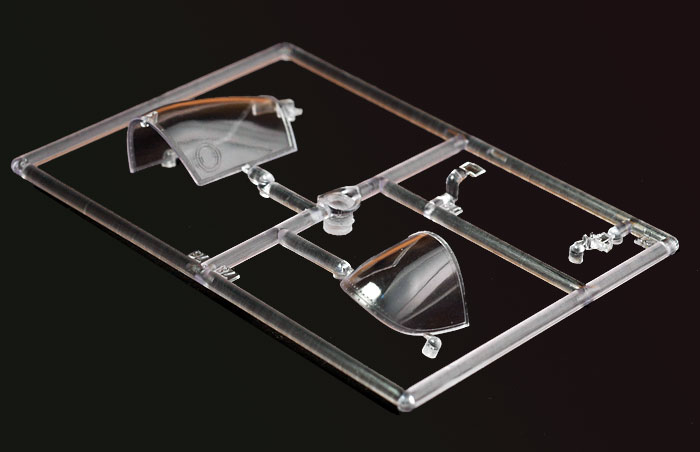
One of the best parts of this job is that I get to see lots of
interesting models and accessories. One of the sad realities is that I
can't build all of them myself! Fortunately, HyperScale is surrounded by
a stellar array of modellers who are willing to help out. It was
therefore with a lump in my throat that I handed the precious white
plastic over to Steve Palffy last night, making plans to progressively
photograph construction during the week.
At 7.00pm tonight the phone rang. It was Steve. "Is your camera
battery charged up?" he asked. Steve had already finished the basic
assembly of the kit.
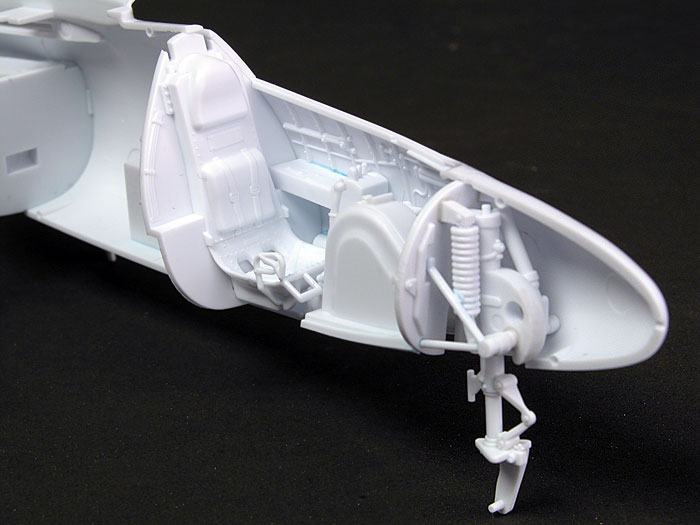
Steve commented that the best fitting, fastest and most enjoyable
aircraft kits that he has built to date are AMtech's Focke-Wulf Ta 183,
and Tamiya's 1/48 scale P-47 Thunderbolt kits, in that order. Having
built these models myself too, I can understand where he is coming from.
His impression is that Revell's 1/32 scale Heinkel He 162 matches the
AMtech kit in terms of exceptional fit, speed of construction and sheer
pleasure.
Even without instructions, Steve took less than half a day to build
the model to this stage, and did not encounter any fit problems. He
approached the model as several sub-assemblies:
- wing halves (port and starboard)
- tailplanes
- engine
- main gear bay and undercarriage legs (installed in port side
fuselage half)
- cockpit (mostly installed in port side fuselage half)
- nose gear and gear bay
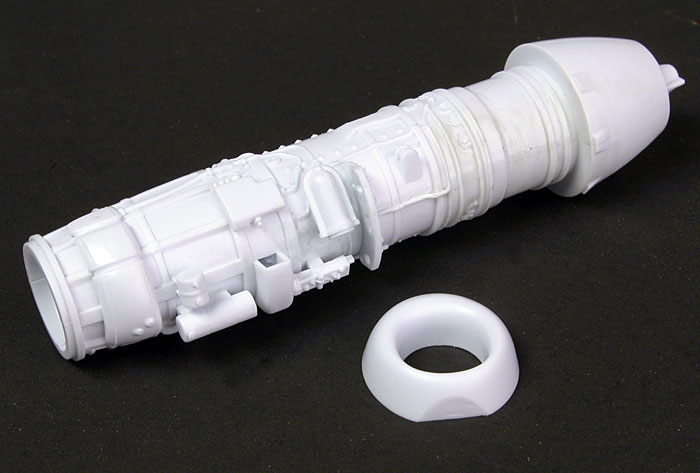
In all of these photos, the fuselage halves are simply taped
together, the wings are slotted into the fuselage without glue, the
engine is resting in its locating holes and the tailplanes are sitting
on the top of the fuselage, also without adhesive. Even so, apart from
the drooping wings - which will obviously be corrected with cement - the
fit can be seen to be superb.
Smaller details, such as gear doors, gunsight, cannon barrels and
canopy, can be added after painting.
Steve was especially impressed with the retraction strut and spring
detail at the front of the nose gear bay. He also liked the detailed
cockpit and the authentically busy main wheel well. The engine is simple
but quite effective too, with its turbine fan installed deep behind the
intake.
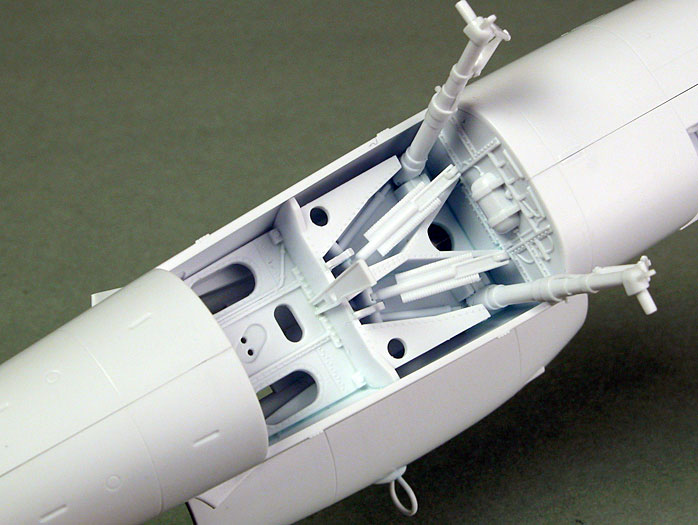
The model still offers modellers some opportunities to add more
detail, especially in the fairly basic gun bay and also with more
plumbing and wiring in the main gear bay, but the result straight from
the box will be impressive regardless.
Noseweight will need to be added to avoid tail-sitting.
We should see this model completed and painted in a Construction
Article over the coming weeks.
Authentic appearance, simple parts breakdown, exceptional fit, easy
construction, good detail, affordable price.
Could a modeller ask for anything more?
Revell's forthcoming 1/32 scale Heinkel He 162 looks like a terrific
model. In this scale, the He 162 is big enough to see the detail but
small enough to display easily. This aircraft also suggests some
interesting conversion possibilities for Luftwaffe '46 aficionados,
including different tail surfaces, wings and powerplants. The
Volksjager wore some colourful markings too. Decal manufacturers
will hopefully jump on that bandwagon fairly quickly.
I would normally reserve recommendation when writing a Preview based
on a test shot, but I think that I have seen enough to rate this kit.
Highly Recommended!
Thanks to Revell GmbH for the review sample.
Click the
thumbnails below to view larger images:
Review and Images Copyright © 2004 by
Brett Green
Page Created 07 September, 2004
Last updated 08 September, 2004
Back to HyperScale Main Page
|
Home | What's
New | Features
| Gallery |
Reviews | Reference
| Forum
| Search